Chinese Institute of Archaeology
Source - http://www.kaogu.cn/en/News/New_discoveries/2015/0317/49593.html
During June and October, 2014, the Archaeological Institute of Heilongjiang Province conducted the excavation of the west city gate of the Shangjing capital city site of Jin dynasty. The excavation covers an area of approximately 1100 square meters, and contributes significant information towards our understanding of the Jin Dynasty.
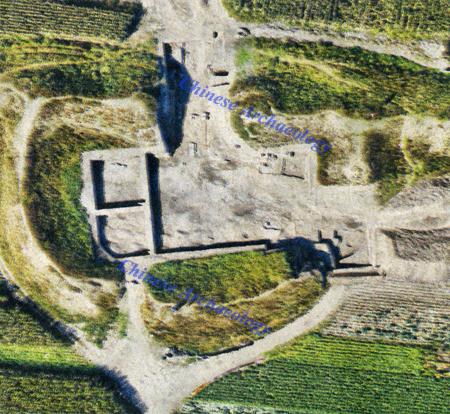
Overview of the West City Gate remains
This excavation recovered the structure of city gates. The west city gate in the south wall of south city is composed of barbican (wengcheng) and gatehouse. There are layers of cultural remains deposited within the gatehouse and barbican, indicating multiple uses of it. The Shangjing capital city site of the Jin Dynasty is located 2kn south to the Acheng district in Haerbin. It comprises the two cities (the south one and the north one), thus forming a shape similar to carpenter's square. The circumference is about 11 km in total while the size is 6.28 square km. Defensive structures such as watchtowers and corner towers were built on the city wall. Several city gates were constructed. In general, the city wall is preserved in good condition.

Remains of gateway (photo from south to north)
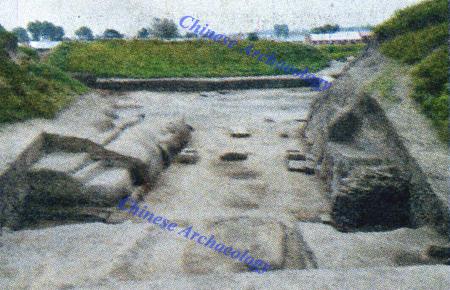
Remains of gateway (photo from north to south)
According to the archaeological survey, there are 6 city gates in total, most of which, unfortunately, have been heavily destroyed. The west gate on the south wall in the south city is an exception as even the barbican is well preserved there. The west gate is made of a gatehouse and a barbican. It is situated on the axis of the imperial city, which is aligned with the Wu gate. Single gateway, ground pavement and the rammed-earthabutment wall on both sides were recovered. The gateway is rectangular in shape. Side stones remained and the relics of threshold were situated in the middle.

Remains of the rammed-earth abutment wall on both sides
Judging from the distance between side stones, the city gate is approximately 6.5 m in width and 20m in length. Outside the side stones stand four wooden pillars on each side, supporting the weight of the gate. There are traces of burning in the gateway, as burnt red earth and carbonized grey earth were discovered in large quantity. The ground stones along with the wooden pillars suggest that there were wooden structures above. The large amount of burnt earth and grey ash indicate that the gate might have been destroyed due to fire hazards. Blue bricks were used to cover the surface of the wall foundation.

The remaining gateway of the barbican
The barbican walls were rammed with earth, whose shape is similar to a horseshoe. The remaining width from east to west is 50m and 20m from south to north. The entrance is located in the southeast. This gate is 4.5 to 5.1m in width, and around 15m in length from east to west. The relatively well-preserved wall with brick-cover in the northeast corner illustrates that bricks were used to strengthen. The barbican gate is located in the east. The remaining gateway suggests a width of 4.5 to5m and length of 15m.
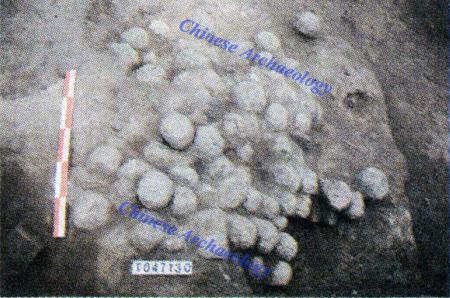
Stone missiles unearthed from the barbican remains
The finding of brick-constructed drainage within the barbican is impressive, providing new insight into the defensive structures during the Jin Dynasty.
A house, which is coded as 2014F1, was found in the northeast corner within the barbican. The dwelling structure is a semi-subterranean house build tightly against the city wall. It shape is similar to cube with length of 4m from east to west and width of 3.2 m from north to south. Three fire pits with two smoke channels for each are situated along the north, east, and west walls respectively. The evidences mentioned above suggest that this house was very likely used by soldiers for guard in the past.
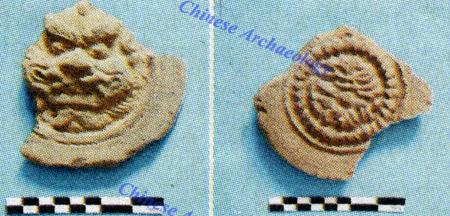
Unearthed tile-ends
According the stratigraphic profile from the southwest wall, the barbican wall might have been repaired and modified for three times totally. Now the remnant of the barbican wall is 11.8 to 13.5 in width and 4.8m in height. Over 500 pieces of artifacts were collected during this excavation, including pottery, ceramics, lithics, bones, iron and copper pieces. Types of artifacts include production tools, daily utilized tools and weapons. Most of them are pottery building elements and iron weapons. Pottery are largely made of grey clay, including jars, vases and urns. Decoration is rare except for several string pattern and attached decoration. Building elements include blue bricks, tile-ends and cylindrical tiles, flat tiles and so forth. Tile-ends are all made of grey clay, decorated mainly with beast faces. There are also a few tile-ends that are decorated with flower and dragon patterns.
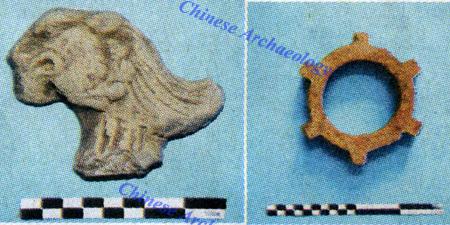
Unearthed pottery statue in shape of phoenix head (left) and Iron chariot implement (right)
White ceramic is predominating in the ceramic catalogue, though there are findings of black glazed and brown glazed wares with small numbers. Ceramic fragments are majorly from bowls and dishes. Iron artifacts are kettles, mini-knives, sickles, scissors, locks, nails, arrowheads, armour and chariot implements. Hair-pins, hooks, awls and rings are present in the catalogue of bone tools. Coopers were used to manufacture crossbows, bracelets, chains and so forth. Among lithics, stone missiles along with limited number of grinding tools were discovered. Copper coins have quite a large collection: 85 pieces in all and 23 different types present. In addition to very few numbers of ‘Kaiyuan Tongbao’ (Tang Dynasty coins), the rest of them belong to the Song Dynasty. Multiple lines of evidences suggest that this west city gate might have been constructed during the middle phase of the Jin Dynasty. To sum up, this is a salient excavation contributing to the research into the archaeology of the Jin Dynasty as well as the archaeology of city in ancient China. (Translator: Dong Ningning)